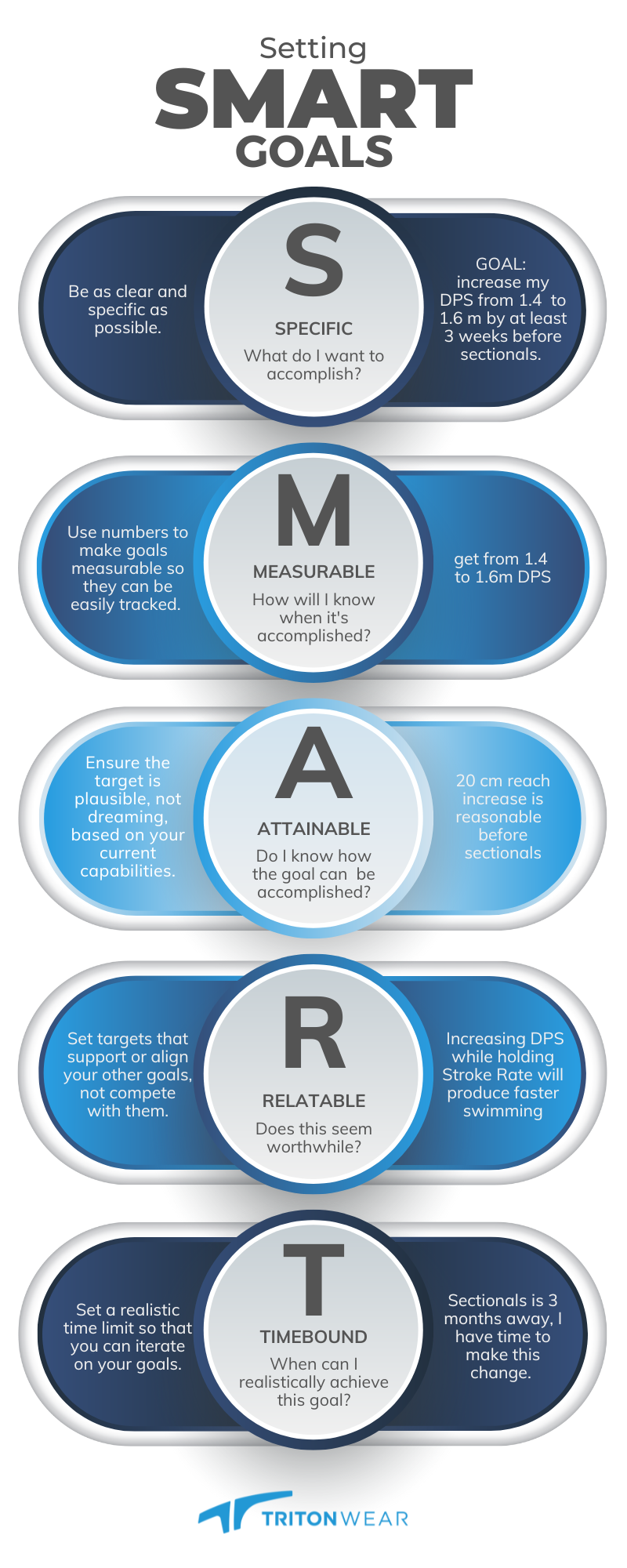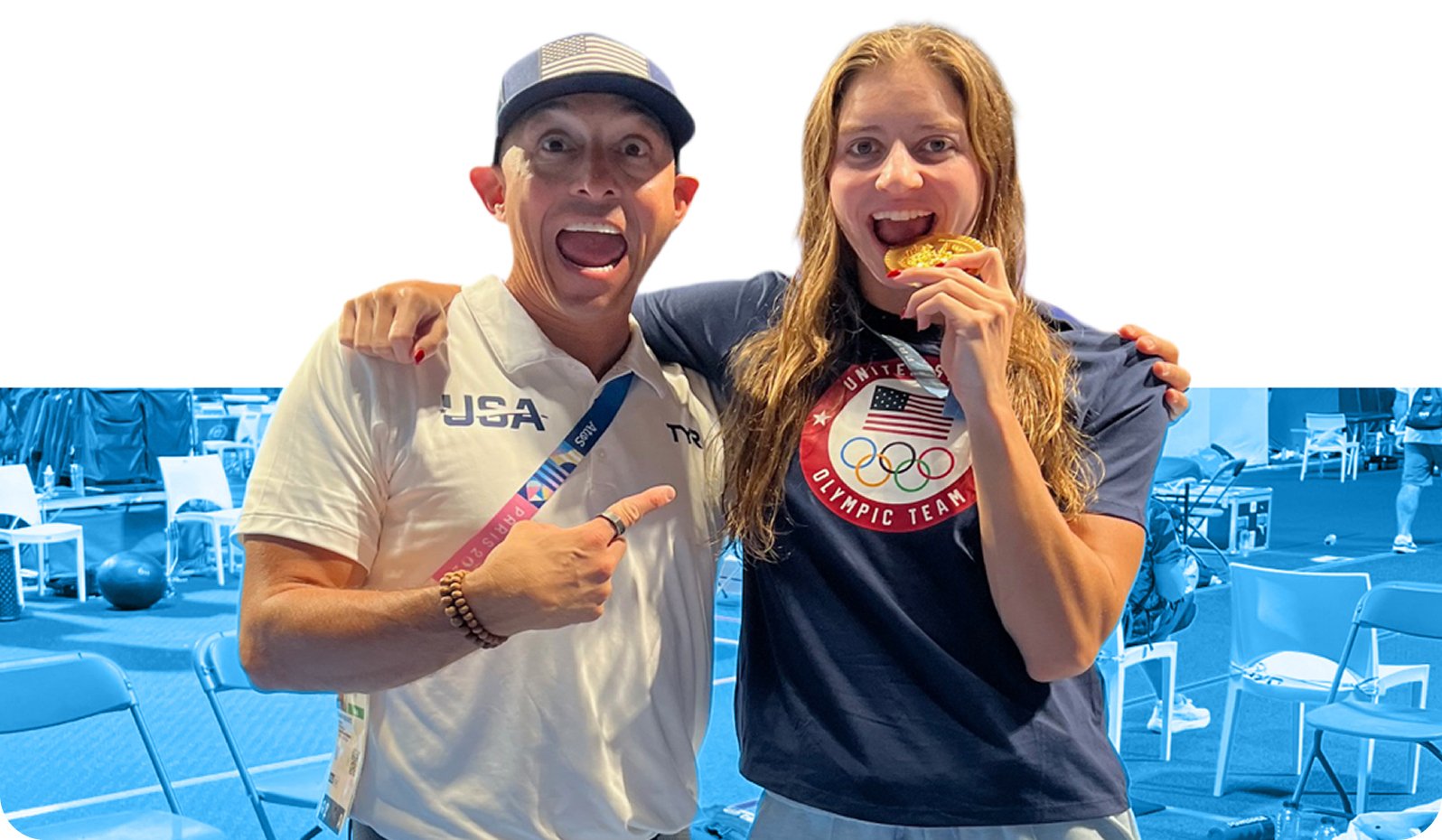As a new season begins, you can feel the electric energy among coaches and swimmers, filled with anticipation for the upcoming meet opportunities. It's a time to reflect on your past performances and a chance to set your sights on the exciting possibilities that lie ahead.
Goal setting early on in the season is an essential ingredient for success in any sport, and competitive swimming is certainly no exception. Whether you're a swimmer aiming to improve your times in the pool or a coach shaping future stars, it's clear that achieving success in the water requires more than just sheer hard work. It demands a strategic approach and a clear roadmap to excellence. That's where SMART goal-setting comes into the picture.
In this blog, we'll delve into the importance of setting SMART goals and provide valuable tips for coaches on how to help their swimmers establish realistic and attainable targets for the year. We'll also explore how wearable technology, swimming analytics, and data can enhance the goal-setting process. And hey, we'll even touch on how goal setting relates to the exciting world of swim college recruiting. Are you ready? Let's dive right in!
What are SMART goals?
SMART goals are the key to unlocking improved performance and a more fulfilling swimming experience for athletes. Most importantly, as their name implies, they are Specific, Measurable, Achievable, Relevant, and Time-bound, providing clear direction and motivation for swimmers to strive towards their targets.
A fun fact about SMART goals is that the concept began to gain traction in sports in the 1990s. Coaches and athletes recognized the value of SMART goals to enhance performance and track progress in their respective sports.
The application of SMART goals in sports is often attributed to the influence of sports psychologists and performance coaches. These professionals started incorporating goal-setting techniques, including the SMART framework, into their training programs to help athletes improve their focus, motivation, and overall performance.
Over time, SMART goals have become a widely accepted and utilized tool in the sports industry. Athletes and coaches across various sports disciplines now regularly employ SMART goals to set targets, monitor progress, and enhance their chances of success. With a better understanding of the SMART methodology, let's now explore how technology can enhance goal-setting in swimming.
Making SMART Goals Even Smarter
First and foremost, in the SMART process is to set goals that are specific. Instead of simply stating, "I want to improve my 100m time," it's important to be more precise about what you want to improve. This is where swimming analytics platforms like TritonWear can help.
With TritonWear, you can set specific goals tailored to your unique needs. This allows you to dive deeper into your performance and pinpoint specific skills that will ultimately help you achieve your desired time.
Instead of a broad goal like "improve my 100m time," you can set a more targeted goal like "increase my Distance Per Stroke (DPS) by 0.2 meters in the 100m butterfly within three weeks." By improving your DPS, you can enhance your stroke efficiency and technique, leading to faster race times. See the difference? Specific goals give you a clear direction to strive towards.
Next up in goal setting is to ensure you set measurable goals. This is especially important in helping you maintain motivation and a sense of accomplishment each step of the way. With the help of TritonWear, you can accurately track and measure your progress. By consistently monitoring your performance using the Triton unit and TritonWear app, you can easily identify improvements in your times, skills, fitness, and other relevant metrics.
This tangible data serves as a solid and inspiring reflection of your progress, boosting your confidence and propelling you to strive for even greater achievements. So, make it a habit to track your workouts daily and note any advancements in your performance. Witnessing your progress firsthand is a powerful confidence booster.
Next, we're moving on to achievable goals. While it's important to challenge yourself, your goals should also be realistic and attainable. Setting impossible goals will only lead to frustration. Coaches, this is where you come in.
Work closely with your athletes to set goals that push them but are within reach. By analyzing the swim data collected with TritonWear, you can identify areas where swimmers can push themselves while ensuring the goals are within reach. This collaborative approach ensures swimmers are constantly progressing without becoming overwhelmed or frustrated.
Furthermore, it's essential to establish goals relevant to a swimmer's overall development and aspirations. With the help of TritonWear's swim data analysis, athletes can gain insights into their strengths and weaknesses, enabling them to set goals that align with their current skill level.
For example, if you have your sights set on competing nationally, you can analyze your performance data and pinpoint the specific skills you need to focus on to qualify for the event. This ensures your goals align directly with your aspirations, providing a clear sense of purpose and direction in your training.
Last but certainly not least, goals need to be time-bound. Setting a specific deadline creates a sense of urgency that keeps you motivated and ensures consistency in your efforts to reach your goal. With TritonWear, athletes can monitor their progress and ensure consistency in their training efforts, ultimately leading to achieving their goals.
For instance, you can set a goal of reducing your 200 Fly time by 2 seconds within three months, identify the skills you need to hone in on to get there and track your progress to stay on target.
This provides a clear target to work towards and allows you to assess your progress and make any necessary adjustments along the way. By monitoring your day-to-day performance with TritonWear, you can determine if you're on track and making the necessary improvements to achieve your goals.

Now that we have uncovered the ways in which technology can elevate the goal-setting process, let's dive into three invaluable tips coaches can use to implement SMART goal-setting in their training.
3 Tips on SMART Goal Setting (For Coaches)
- Tailoring goals to individual abilities: Each swimmer is unique, with different strengths and areas for improvement. Take the time to understand their strengths and weaknesses and tailor their goals accordingly. By setting challenging and attainable goals, you can help your swimmers stay motivated and focused on their progress.
- Involving swimmers in the process: Encourage open communication and active participation from your swimmers. Ask them about their aspirations and challenges. By involving them in decision-making, they will feel a greater sense of ownership and commitment to their goals. This involvement also allows you to understand their perspective and provide guidance accordingly.
- Breaking down goals into milestones: Big goals can sometimes feel overwhelming. Help your swimmers identify specific steps they need to take to reach their ultimate objectives. These smaller milestones should be measurable and time-bound, providing clear progress indicators. By focusing on these achievable targets, swimmers can maintain their motivation and track their advancement along the way.
Remember, goal-setting is not a one-time activity. Regularly review and adjust goals as needed, and provide constructive feedback to your swimmers. Celebrate their achievements, maintain open communication, and foster a supportive environment. By following these tips, you can guide your swimmers toward success in the pool and help them achieve their full potential.
As for the swimmers graduating high school, SMART goal setting can have a significant impact on their transition to collegiate swimming. Setting clear and achievable goals during this crucial period can help swimmers navigate the challenges and expectations of collegiate swimming programs.
The Impact of SMART Goal Setting on Swim College Recruitment
College coaches are always looking for swimmers who possess determination, dedication, and a clear vision of their swimming goals. When swimmers can effectively communicate their objectives and demonstrate their unwavering commitment to achieving them, it can significantly impact their chances of being recruited by college swimming programs.
For aspiring collegiate swimmers, it is crucial to establish specific and measurable goals that encompass their swimming performance, academics, and personal development. By doing so, they showcase their unwavering dedication and highlight their true potential to college coaches during the recruitment process.
Given the current emphasis on racing times, it can be quite challenging for swimmers to showcase their abilities beyond the pool. However, TritonWear provides an incredible opportunity for swimmers to invite and share their training insights with recruiting coaches from their desired colleges.
By granting coaches access to their training data, swimmers can provide a comprehensive overview of their skills, intensity, and training readiness. This invaluable information enables coaches to make more informed decisions and truly grasp the swimmer's potential.
Key Takeaways
In a nutshell, the key to success in competitive swimming lies in setting SMART goals. These goals, which are Specific, Measurable, Achievable, Relevant, and Time-bound, provide swimmers with a clear sense of direction and motivation. With the help of technology like TritonWear, swimmers can customize their goals to their unique needs and track their progress through data analysis.
Coaches play a vital role in this process by tailoring goals to individual abilities, involving swimmers in decision-making, and breaking down goals into manageable milestones. SMART goal setting also plays a significant role in swim college recruitment, as it demonstrates swimmers' unwavering dedication and potential to college coaches. By effectively communicating their goals and utilizing technology to showcase their skills, swimmers can greatly increase their chances of being recruited.



.png)

.png)